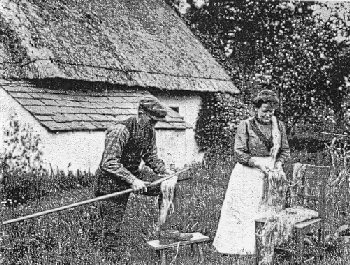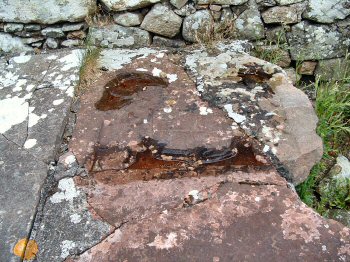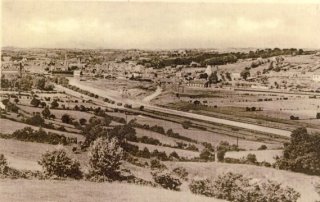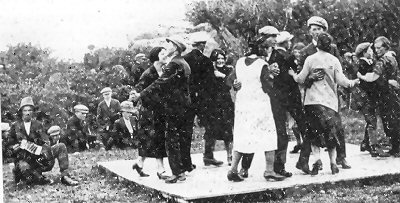Culture
Fews Glossary Y-Z
Vapour boast: ’till hear him vapour, ye’d think he owned the townland’
Words quarrel: ‘we’d words once, but we don’t spake now’
cross words: ‘We’d words, and now we’re fell out’
Yalla yellow
Yammer complain
Yap complain, gern: ‘quit yapping there!’
n. ‘he’s nothing but a wee yap’
yerk pull: ‘he yerked me be the arm’
‘he was yerked into the ditch’
Yoke car, machine: ‘that’s a quare yoke yer driving’
Matched: ‘them two’s well-yoked’
Yon that
Your day generation: ‘Aye, twas different in your day!’
Yowl cry, yelp
Burial Customs
‘On the day of a funeral, a large concourse of people assembles who are plied with spirits, generally two glasses. The corpse is then placed on the bier which is covered with a pall. It is then hoisted on men’s shoulders and they are followed by the keeners who intone alternatively all the way to the burial place. The bearers are relieved frequently by others.
It often happens that if another funeral should appear from a different direction that a scene of competition commences for precedence. Sometimes it turns into strife or riot. In explanation of this custom we have heard it said that when graveyards were not hedged about, it was usual to post a sentinel at night to watch the graves from wild beasts and every other thing to which they might be exposed. (Editor: perhaps the sensibilities of his religious office caused Rev Nelson not to mention the greatest danger from grave-robbers). This office fell to the relatives of those who had been last buried in the cemetery.’ [Nelson, 1840]
Ringworm Cure
Funeral Customs
‘The wakes and funerals of the Irish,’ wrote Rev Nelson in his History of Creggan Parish (1840), ‘are no less interesting. On death the corpse is carefully washed over and, if an adult, dressed in the usual manner. It is placed under board, as it is called, that is, on a long table (often provided by the funeral undertakers who keep one for the purpose) about six foot long and two foot wide but when this cannot be got, two small tables pushed together and draped with a white sheet. The corpse too is covered in a white sheet as is the wall at its head. To the latter are attached great quantities of emblematic pictures of crucifixion, resurrection etc. The table under which the corpse is laid is covered with candlesticks varying in number according to the circumstances and respectability of the deceased. The number is always odd and varies from three to thirteen.
The Rhymers or Keeners, mostly women, are sent for from a considerable distance to perform the funeral rites. Arriving at the house they partake of some refreshment and a glass of whiskey (Are these things different? Ed) then the females are arranged into two divisions, one on each side of the corpse. One of the Keeners then begins her lamentation in Irish, expressing some of either the good or the bad qualities of the deceased, or a number of foolish rhetorical questions such as, ‘Why did you die?’ or ‘Did you not like the world?’ The Keenagh or cry then goes up and all join in. The Rhymers on the other side then begins her lament and is joined in like manner by the rest, the one praising, the other disparaging the corpse.
Many Cures
Fews Glossary: I
Ill-answered impertinent
Ill-favoured physically unattractive
Ill put-on badly dressed
Ill done done wrongly
Ill to handle difficult (of person or beast)
Ill off in straitened circumstances
Ill tongued prone to swearing, or verbal abuse
Took it ill was displeased about
Imparted scolded: ‘I imparted my mind to her!’
Imperent impudent
Ins and outs all: ‘give me the ins and outs of it!’
Insense to make someone understand
In under beneath: ‘he fell in under the cart’
In with on friendly terms: ‘Are ye in with them?’
I know these are out of sequence but I’d better record them before I forget. I’m grateful to my friend Bridie McVeigh for the second one below.
Yer ar*e ‘n parsley You’re telling whoppers!
Ceillayly: She’s just an aul’ ceillayly She’s flighty and fickle – always on her ceili
The Rose
We have John and Annette Macan with us for three weeks and yesterday your editor gave them the personal touch, with the whirlwind tour of the Ring of Gullion. They were greatly impressed and why would they not be?
I learned that besides professional counselling, John dabbles in acupuncture and Chinese herbal medicines. For the benefit of the odd patient not partial to pin-cushion treatment, I print below one traditional Irish cure for a common ailment. [More ‘cures’ later!]
Erysipelas as you know – or your medical dictionary will inform you – is a skin disease involving a diffuse and spreading inflammation of skin and subcutaneous cellular tissue especially of the face, neck, forearms and hands, caused by Streptococcus pyrogenes.
Too technical, all that! This is what my source, an old lady from Annahaia told me of it.
‘It might take ye anywhere but it’s a gentle thing, a very gentle thing, an’ the cure is one the doctors know nothing of. Your head might swell up big an’ red as anything. The Lord save me from having it agin an’ keep ye from it too.
I was tuk till the bog-hole but I first went till the doctor. An’ says he,
‘It’s some oul’ woman ye want! It’s she will tell ye what till do.’
He wus Dr Quinn’s father and the quare civil man. I min’ the lot of them an’ sure the world an’ all knowed me.
I’m the aul’ standard, I am, an’ I nivir lay off me work yit, even when I had me ankle sprained in the flax-hole. There’s no dirty blood in me or anything like that!
But ‘The Rose’, God save ye from that! It wus in me face I had it an’ it wus in a terrible rage. But min’ ye, ye cud take it anywhere: in yer legs or in yer feet. But sure it wus in me face I tuk it. An’ the cure wus a boy an’ a girl whose father and mother wus livin’ an’ nine wee stones from off the road.
It wus Peter tuk me an’ we went till the oul’ Red Bog at Larry’s, an’ Peter threw a stone in the name of the Father, Son and Holy Ghost, an’ then lifted water an’ bathed me face.
Then he stuck he’s hand in the bog-hole and brought out a poultice of bog-mud that wus placed on the spot, an’ sure in the mornin’ it wus gone.
An’ I wus big then, a near grown girl, but I min’ it worked well.’
You’ve got bogs in the Brisbane area, don’t you, John?
Which reminds me! Paddy and Seamus Murphy determined to put the past behind them and emigrate to Australia. It was slowly explained to them that things weren’t that easy any more. Way back in the 50s, Australia would take most applicants but now they wanted only skilled tradesmen. They had to undergo a test.
‘And what do you do, by way of making a living?’ Paddy was asked.
‘Oh, pilot!’ he replied breezily.
‘That’ll do fine!’ says yer man of the Embassy. ‘We can always find work for a man of your talents.’
Paddy left smiling and gave the thumbs-up to his brother Seamus who was entering for interview after him. Seamus smiled in response.
‘And what do you do for a living?’ Seamus was asked.
‘I’m a turf-cutter,’ Seamus replied.
‘I’m sorry Seamus, we have few bogs in Australia and no work for men of your talents.’
Seamus was devastated.
‘But you let my brother Paddy in,’ he countered.
‘But he’s a pilot!’ the Ambassador said.
‘Sure he can’t pile it till I cut it!’ Seamus rejoined…
Weather Signs
If it rains on St Swithin’s Day, it’ll rain for 40 days
Cows huddle together before a storm
When the wind’s in the west the cuckoo’s in her nest
When a dog eats grass it’s a sign of rain
A wind from the East is bad for man and beast
When the robin ventures indoors, hard weather may be expected
As Friday’s weather, so Sunday’s weather
Rain on Sunday, rain all week
If bees work around the hive, the rain is near
If the cat sneezes it is a sign of rain
March of many weathers
If the oak is well-acorned it’s a sign of frosty weather
If the frog wears a golden coat, the weather will be fine
If he puts on his black coat, rain is on the way
A sloe year is a woe year
A haw year is a braw year
A ring around the moon is a sign of bad weather
If the ring is close, the storm is near, if distant, further away
A wind from the south-west foretells wet weather
Candlemas storms and Lammas floods must come
The March winds had almost killed the old cow, so March borrowed a day from April to finish the job
It’s cold weather for snedding turnips!








